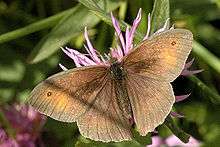Monkspath Meadow
| Site of Special Scientific Interest | |
| Area of Search | West Midlands |
|---|---|
| Grid reference | SP145763 |
| Interest | Biological |
| Area | 1.2 hectares |
| Notification | 1986 |
| Location map | English Nature |

Monkspath Meadow is a 1.2 ha (3.0 acres) ancient hay-meadow and a biological site of Special Scientific Interest in the West Midlands.[1] The site was notified in 1986 under the Wildlife and Countryside Act 1981. It is on the south-eastern edge of Monkspath. The site has recently been targeted for development for houses but these plans have been met with uproar from locals in Monkspath and nearby villages, such as Cheswick Green and Hockley Heath, as it would destroy such a special natural site.
The site has probably been used as a hay meadow for over 800 years, and has not been ploughed for at least 200 years. It was originally at risk of development from the construction of a new local supermarket and garden centre in 1986. A little over half of the site was saved from development by a campaign led by Members of Warwickshire Nature Conservation Trust when proposals for the new supermarket were outlined. The remaining 1 ha (2.5 acres) of meadow was relocated in 9 in (23 cm) deep turves to a new site at Temple Balsall.[2]
Today Notcutts Garden Centre manages the site under the direction of English Nature. The meadow supports a diverse level of flora with over 150 recorded species, including various grass species such as common bent (Agrostis capillaris), red fescue (Festuca rubra), Yorkshire fog (Holcus lanatus) and tufted hair-grass (Deschampsia cespitosa). Herbs include cowslip (Primula veris), betony (Stachys officinalis), great burnet (Sanguisorba officinalis), Dyer's greenweed (Genista tinctoria), meadow thistle (Cirsium dissectum), saw-wort (Serratula tinctoria), heath grass (Danthonia decumbens), heath spotted orchid (Dactylorhiza maculata), and common spotted orchid (Dactylorhiza maculata). Fauna includes for small heath (Coenonympha pamphilus), meadow brown (Maniola jurtina) and common blue (Polyommatus icarus) butterflies.[1]
The site is open to the public under the guidance of Warwickshire Wildlife Trust on one or two weekends per year. Local schools are also encouraged to arrange field trips.[2]
See also
- List of Sites of Special Scientific Interest in the West Midlands
- Ragged Robins Nature Notes: webpage for Monkspath meadow
References
- 1 2 "Natural England SSSI Citation for Monkspath Meadow" (PDF). Retrieved 13 July 2013.
- 1 2 "Solihull borough council website: Biodiversity & Grassland Management". Retrieved 13 July 2013.
Coordinates: 52°23′04″N 1°47′18″W / 52.38454°N 1.78839°W